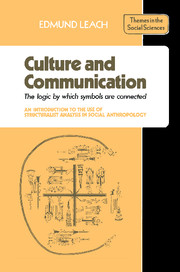 Culture and Communication
Culture and Communication Published online by Cambridge University Press: 05 June 2012
I want now to return to the problem which I raised earlier (Section 6) of how far we can distinguish the logic of technical actions from the pseudo-logic of expressive actions.
In our own Western, literate, mechanically organised society, so much ‘true’ Aristotelian logic is built into the cultural system that we mostly take it for granted that logic of this kind is an essential component of common sense. Yet in practice we only exploit formal logical principles in the relatively rare instances in which we are seeking to convey exact information at a distance using a single channel of communication, as in writing a letter or a book or speaking to someone over the telephone. When two people are in face to face communication, so that they can use several channels of sensory information simultaneously – touch, sight, hearing and so on – the logical ordering of individual messages is much less obvious.
If you record unrehearsed conversation on tape you will find that on play-back very little of it is immediately comprehensible; yet, in context, all those present would have understood what was being said. This is because, in its original setting, the spoken utterance was only part of a larger whole. It had a metonymic (sign) relationship with everything else that was going on in the room at the same time, and this non-verbal ‘other’ was also conveying part of the message.
But the same argument applies the other way round. When an anthropologist tries to decode a set of non-verbal indices he needs to remember that he has only got part of the evidence.
To save this book to your Kindle, first ensure [email protected] is added to your Approved Personal Document E-mail List under your Personal Document Settings on the Manage Your Content and Devices page of your Amazon account. Then enter the ‘name’ part of your Kindle email address below. Find out more about saving to your Kindle.
Note you can select to save to either the @free.kindle.com or @kindle.com variations. ‘@free.kindle.com’ emails are free but can only be saved to your device when it is connected to wi-fi. ‘@kindle.com’ emails can be delivered even when you are not connected to wi-fi, but note that service fees apply.
Find out more about the Kindle Personal Document Service.
To save content items to your account, please confirm that you agree to abide by our usage policies. If this is the first time you use this feature, you will be asked to authorise Cambridge Core to connect with your account. Find out more about saving content to Dropbox.
To save content items to your account, please confirm that you agree to abide by our usage policies. If this is the first time you use this feature, you will be asked to authorise Cambridge Core to connect with your account. Find out more about saving content to Google Drive.